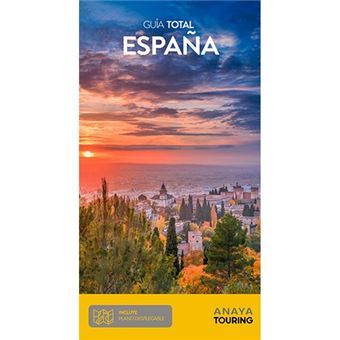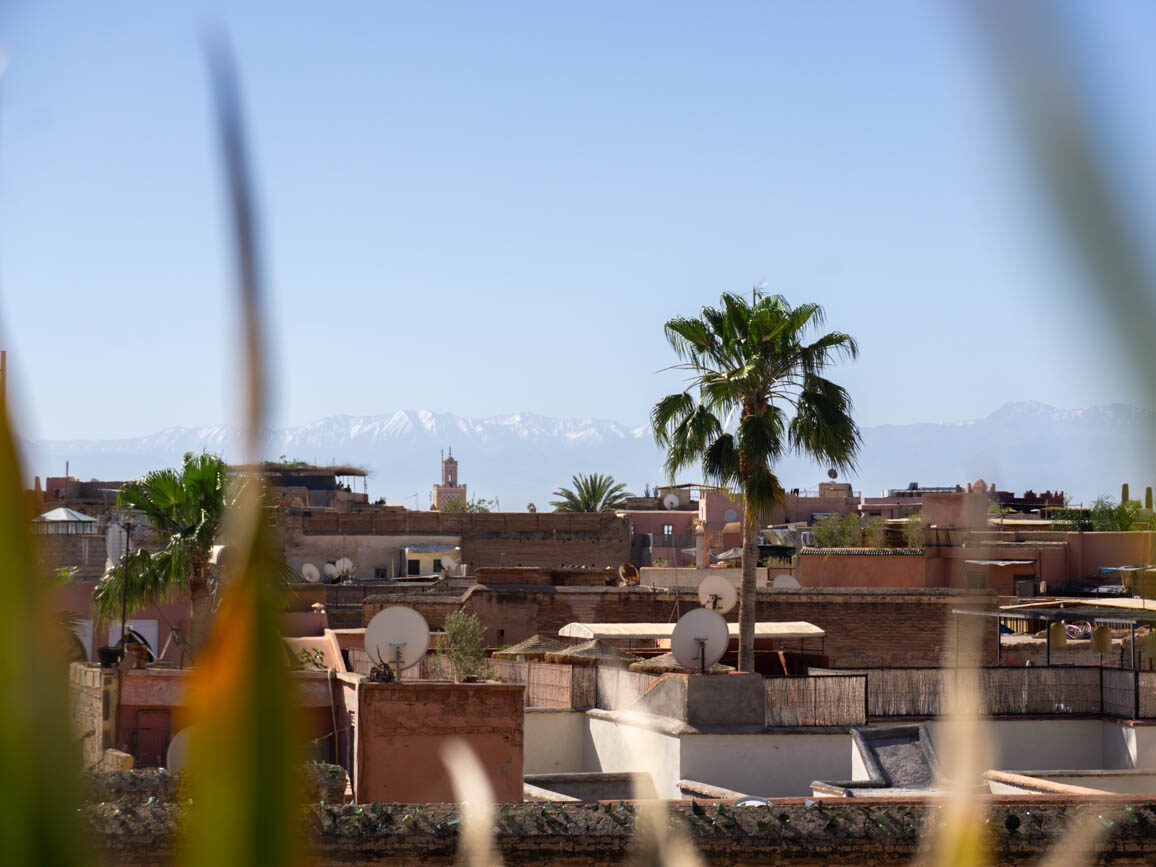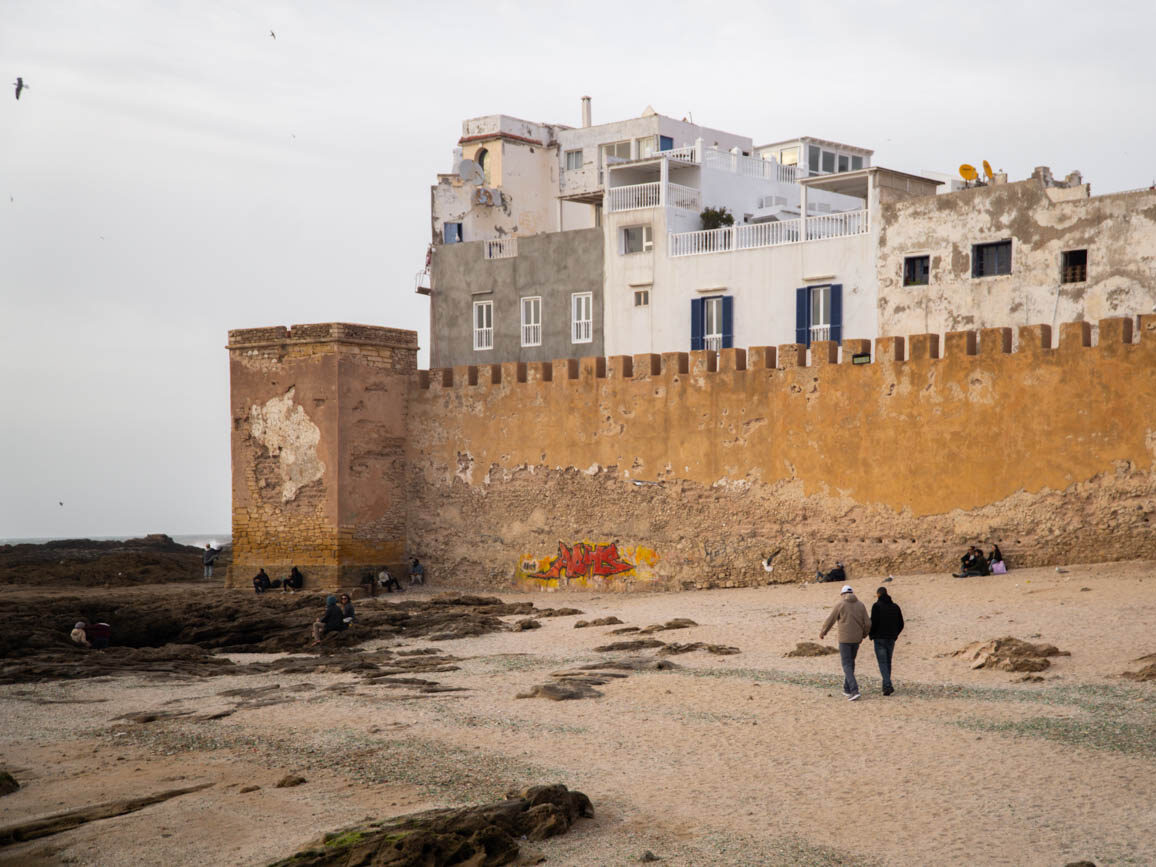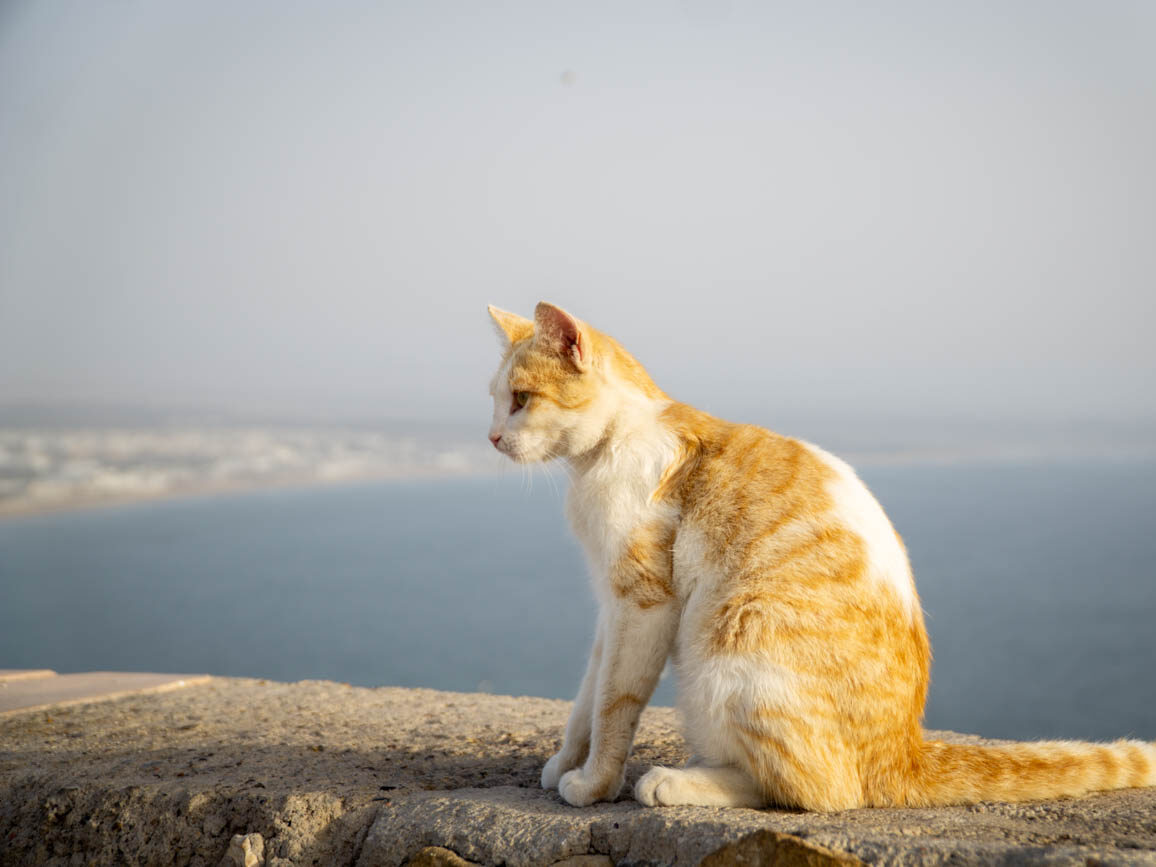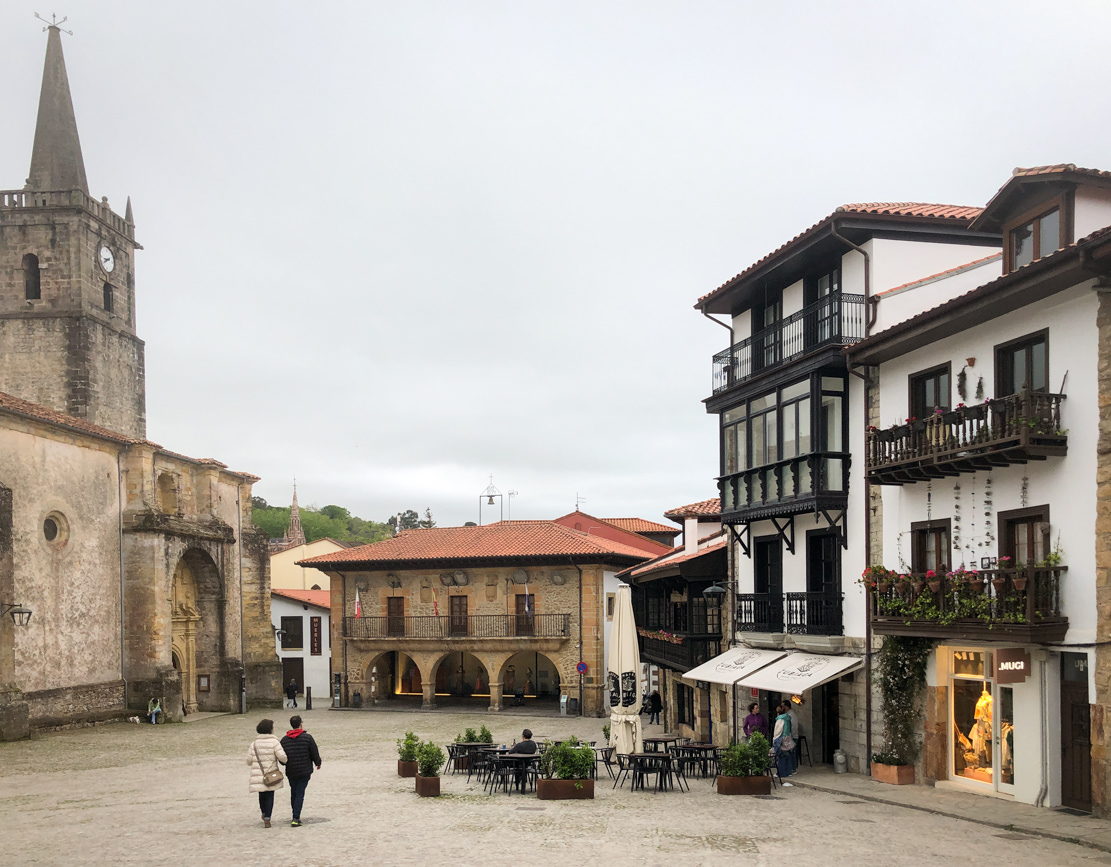
A 7-day Spain road trip around 16 monumental destinations
Follow me on this 1.500 km circular road trip exploring 16 monumental Spanish cities around various regions of the country, including Cantabria, Asturias, Castilla y León, Castilla la Mancha, Comunidad de Madrid, La Rioja and Navarre. Among other things, we visited fascinating destinations, admired imposing heritage and tried delicious food. Ready to jump into this epic Spain road trip?
[Disclaimer: please note that this post includes some affiliate links. This means that, at no additional cost for you, I earn a commission if you make a purchase. In case you have any question about the companies advertised here or my status as an affiliate, please do not hesitate to contact me.]
In order to plan this trip, find out what to see and do in each destination and where to eat, I used the following Spain travel guide by Anaya Touring. It’s really comprehensive, with plenty of useful information such as pictures and maps for major cities. At the end of the guide, you will also find a list with spot-on suggestions of restaurants and hotels sorted out by city. I can’t recommend it enough!
Our Spain road trip itinerary
| OUR SPAIN ROAD TRIP IN NUMBERS |
|---|
| Total distance: around 1.500 kms |
| Number of destinations that we visited: 16 |
| Duration: 7 days |
| Regions that we visited: 7 |
Before diving into each of the destinations that we visited during this family road trip, here’s an overview of our 1.500 km itinerary, broken down by day.
- Day 1: Irún, Santander, Comillas
- Day 2: Sariego, Oviedo
- Day 3: León, Tordesillas
- Day 4: Simancas, Medina del Campo, Segovia
- Day 5: Alcalá de Henares, Guadalajara
- Day 6: Sigüenza, Medinaceli, Soria
- Day 7: Logroño, Puente la Reina
For your ease of reference, under each destination below I provided some basic information including the exact region (or Comunidad Autonóma) and province they belong to, along with the main sites to visit in every city or village. Further down, you will also find what and where we ate as well as where we slept during our Spain road trip.
At the end of this post, I also included a map so you can easily pinpoint all the places mentioned here.
Are you ready to join me on this road trip around northern and central Spain?
Day 1: Irún, Santander, Comillas
On our first day, we left my hometown Irún early in the morning to start our Spain road trip.
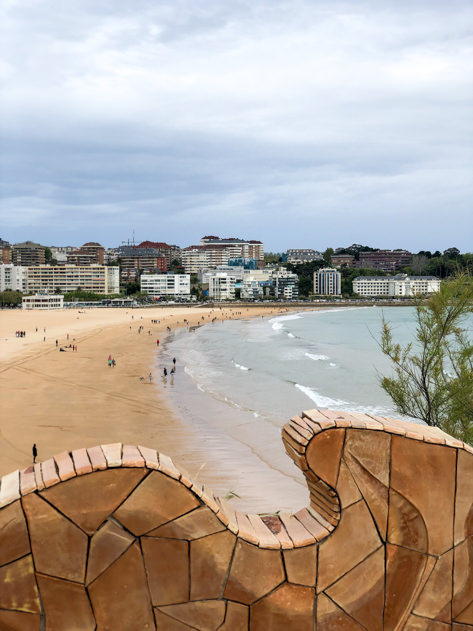
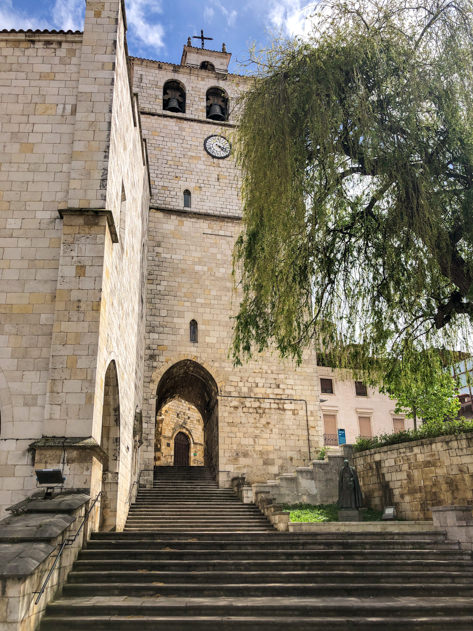
Santander
Region: Cantabria (Santander is the capital)
Our first stop during this Spain road trip was Santander. This modern, cosmopolitan and elegant city overlooking a spacious bay (bahía de Santander) hosts one of the most beautiful promenades on the Spanish coast, and also offers a lively urban and cultural life closely linked to the Menéndez Pelayo International University (UIMP).
Wondering what to do in Santander? Below are the main highlights to visit:
- Centro Botín, art museum designed by Renzo Piano in 2017 right by the docks and next to the gardens of Jardines de Pereda.
- Palacio de la Magdalena: located in a peninsula, this palace became the summer residence of the Spanish Royal Family between 1913 and 1930. This whole area is perfect if you’re visiting with kids as there’s a big playground, a mini zoo with cute penguins, sea lions and seals, and even a train to take you around.
- Playa del Sardinero: this is the most iconic beach in Santander, but since it’s a coastal city, you can find many others such as Playa Los Peligros, Playa del Camello, Playa de la Magdalena or Playa de la Concha.
- Old Town, encompassing the most important civil, commercial and religious buildings such as Catedral de Santander, Mercado de la Esperanza, Plaza del Ayuntamiento or Plaza Porticada.
- Walk along Paseo de Pereda, connecting the port area with the marina (Real Club Marítimo Santander).
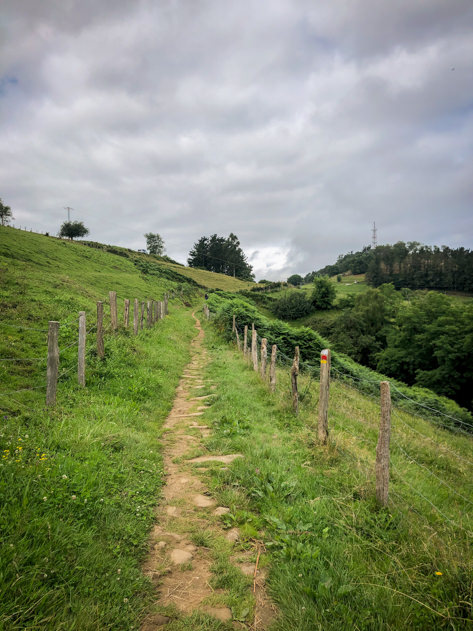
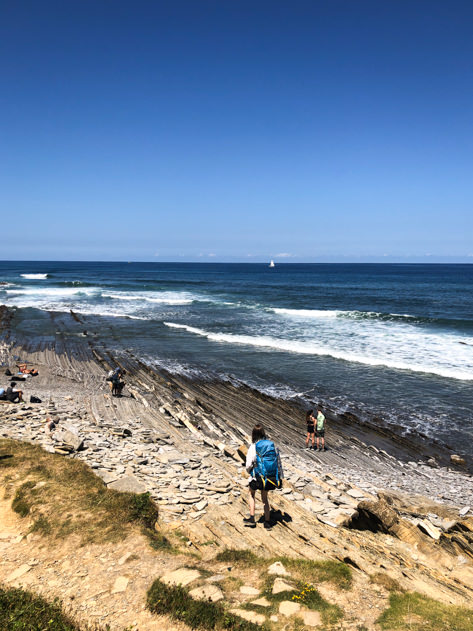
Actually, the city of Santander is one of the major milestones along the Northern Way of the iconic Camino de Santiago. Also known as ‘Camino del Norte‘, this itinerary is one of the most primitive trails and it runs along the Atlantic coast in northern Spain until Ribadeo in Galicia, before turning southwest. Around 800 kilometers separate the starting point in my hometown, Irún, from the final destination in Santiago de Compostela.
Read my post | Camino de Santiago: hiking from Irún to Deba along the ‘Camino del Norte’
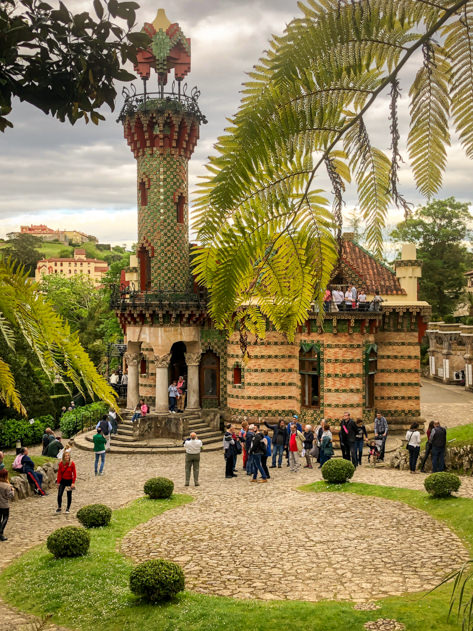
Comillas
Region: Cantabria
Just 40 kms away from Santander lies the coastal village of Comillas. Despite its humble past as a whaling port with fierce fishermen, it became a highly popular summer destination for the royals in the 19th century (and it still is nowadays). As a result, it preserves an important legacy of modernist architecture from renowned Catalan figures. Comillas is actually considered one of the most beautiful villages in Spain.
Here’s what you can’t miss in Comillas:
- Capricho de Gaudí: this unique and whimsical country house built in 1885 is one of the only three works by Antonio Gaudí that is located outside of Catalonia (the others being the Episcopal Palace of Astorga and Casa de los Botines in León). I loved paying attention to all the architectural details, from the sunflower-shaped tiles to the delicate wrought iron balconies. Also, make sure to walk around the garden for a great perspective of this curious building.
- Cementerio de San Cristóbal: even though it might seem odd to include a cemetery as part of your itinerary, some are worth the detour and this one is no exception. Make sure to see the haunting statue of Ángel Exterminador, by Llimona, as well as the elaborate mausoleum of the Piélagos family. To finish off on a high note, admire the views of the Cantabrian Sea!
- Palacio de Sobrellano: this imposing palace features a spectacular façade and an even more elaborate interior. Now housing a museum, it was built as the summer residence of Antonio López del Piélago, an adventurous local who made a fortune in Cuba (these were called ‘indianos‘) and was later named the first Marquis of Comillas. The adjacent neo-Gothic pantheon chapel with marble sculptures by Llimona is also beautiful.
- Parque Güell y Martos: in this park with breathtaking views of the Cantabrian Sea, you will find a monument dedicated to the Marquis of Comillas designed by Domènech i Montaner, as well as Casa del Duque de Almodóvar del Río.
- Playa de Comillas: you can head to the beach and stroll around the charming fishing port. Other nearby beaches include Playa de Oyambre and Playa de Merón.
- Puebla Vieja: explore the Old Town, including the medieval square housing the former City Hall, Plaza del Corro, intricate streets and modernist fountains.
- Universidad Pontificia: this massive building and former seminary, was also designed by modernist architects Martorell, Cascante and Domenech. It now houses Fundación Comillas.
Discover more destinations in Cantabria.
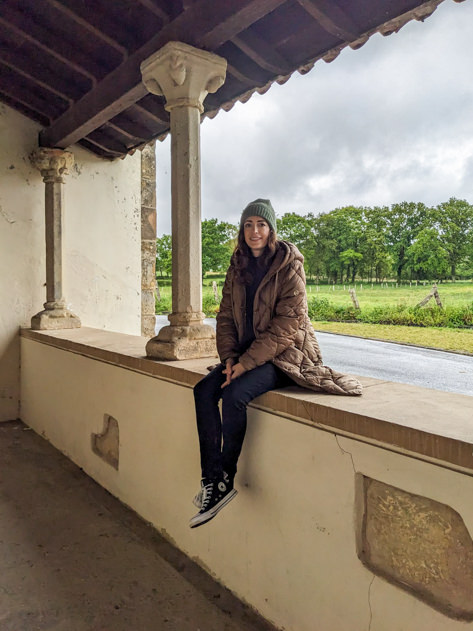
Day 2: Sariego, Oviedo
Sariego
Region: Asturias
On our way from Comillas to Oviedo, we stopped in Sariego – La Vega for a personal reason. This small village in the region of Asturias is where my Mom’s great-great-grandparents were born! So we just wanted to walk down memory lane a little bit, ask locals around about our relatives, and pay a visit to the church where they were baptized (iglesia parroquial de Santiago) and the nearby cemetery.
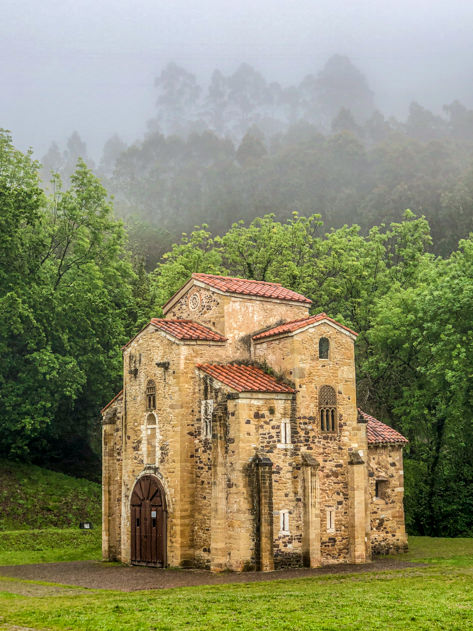
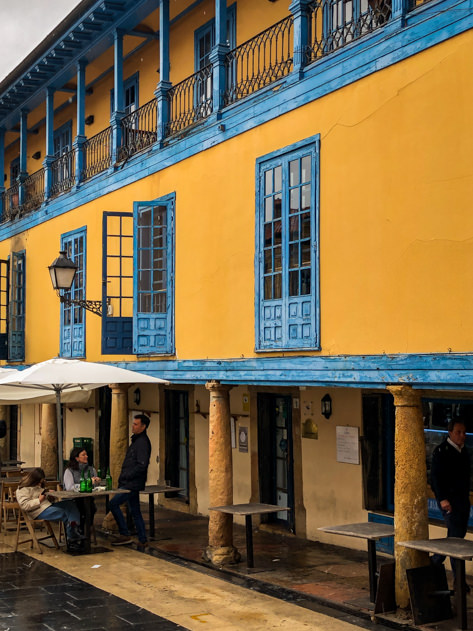
Oviedo
Region: Principality of Asturias (Oviedo is the capital)
We arrived to Oviedo (also known as Uviéu) around lunch time under rainy weather. The city holds a rich historical and artistic legacy, featuring pre-Romanesque vestiges that are considered a UNESCO World Heritage Site since 1985. Nowadays, Oviedo is also a lively town thanks to its numerous University students.
These are the must-see highlights in Oviedo. Although most of the sites are concentrated in the Old Town area, some others can be found in the outskirts:
- Catedral de Oviedo: the imposing Cathedral is certainly THE place to visit when you’re in town. Built in Gothic style during the 15th and 16th centuries, the cathedral is dedicated to San Salvador and is also known as Sancta Ovetensis. The elements you can’t miss in this temple include a Renaissance altarpiece, the Romanesque statue ‘El Apostolado‘ depicting the twelve apostles, and the Holy Chamber (Cámara Santa) that holds a large number of relics including Christ’s shroud. Furthermore, you may want to explore the cloisters and the garden known as the pilgrims’ cemetery.
- Museo de Bellas Artes de Asturias: this museum of Fine Arts displays artwork and sculptures from regional artists, as well as from Spain and other parts of Europe.
- Museo Arqueológico: this archaeological museum was a former monastery. It also houses a cloister dating from the 15th century.
- Plaza del Fontán: this rectangular square with arcades lies next to a market (Mercado del Fontán). This was definitely my favorite spot, so colorful and picturesque!
- Plaza de la Constitución, where you will find the City Hall (Ayuntamiento) built in 1622.
- Palacio de Exposiciones y Congresos Ciudad de Oviedo: this modern complex designed by architect Calatrava hosts conventions and exhibitions.
- Every year towards the end of October, the iconic Hotel de la Reconquista and Teatro Campoamor host the main cultural event in Oviedo. On behalf of the Fundación Princesa de Asturias, the Princess of Asturias and heir to the Spanish throne awards the famous homonymous prizes to important figures in various categories including Arts, International Cooperation or Sports during a moving ceremony with traditional bag-pipers. As a matter of fact, American director Woody Allen received one of these awards in 2002, fell in love with Oviedo ever since, and chose the city as one of the settings for his movie Vicky Cristina Barcelona in 2008. You can actually find his life-size bronze statue in Calle Milicias Nacionales. Nearby, in the park Campo de San Francisco, there´s also a statue of the famous comic character Mafalda.
- Pre-Romanesque temples in the outskirts of Oviedo: iglesia de San Julián de los Prados located in Santullano, iglesia de Santa María del Naranco and iglesia de San Miguel de Lillo built in the 9th century. These two can be found further to the northwest in Monte Naranco, from where you can admire breathtaking views of the city!
Day 3: León, Tordesillas
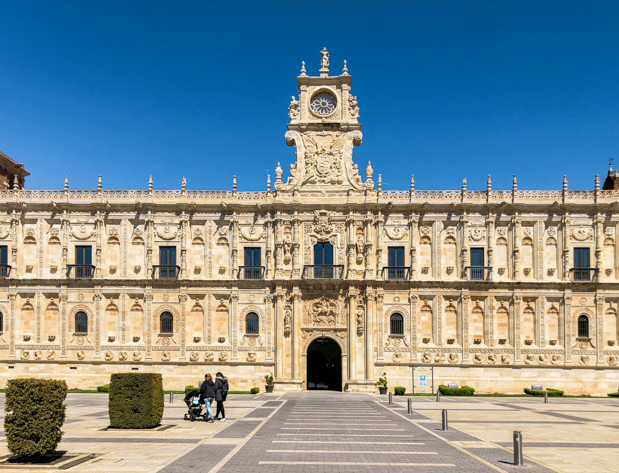
León
Region: Castilla y León
Province: León (it is the capital)
Seat of the ancient kingdom of León, the homonymous city still features a valuable monumental legacy to this day. The legendary French Way (Camino Francés) along the Camino de Santiago runs through a number of incredible Spanish cities, including León or Logroño, to just name a few.
- Catedral de León : also referred to as Pulchra leonina, this imposing Gothic cathedral is undoubtedly the main highlight in the city. Constructed towards the middle of the 13th century, this temple features some elements worth mentioning such as its three facades, magnificent stained glass windows, an elaborate retrochoir, notable paintings from the 15th century, various chapels (including the one dedicated to the Virgen del Dado), a cloister and a museum. Make sure to book in advance if you want to get in!
- Casa Botines: erected at the end of the 19th century by the brilliant Gaudí, this singular neogothic masterpiece now houses a museum. I recommend you go up the steps of the nearby city wall for a better perspective (and photo op :)).
- Museo Pallarés: just a few steps away lies another museum offering a complete overview of the provincial history, culture and heritage ranging across centuries.
- Elegant palaces such as Palacio de los Guzmanes or Palacio del Conde Luna.
- Hostal de San Marcos: this former hostelry built between the 16th and 18th centuries in plateresque style was reconverted into a luxurious hotel in 1986 (Parador de León) and also houses the local museum. Make sure to admire its elaborate façade, the coffered ceiling in the chapter hall and the cloister.
- Plaza Mayor: around this porticoed square built in the 17th century, you will find other civil and religious buildings such as the old City Hall, two churches dedicated to San Martín and Santa María del Mercado and the square known as Plaza del Grano o del Mercado, which was used as an old grain market.
- Plaza y Basílica de San Isidoro: this basilica can be found in the square of the same name. It was built between 1056 and 1067 to host the remains of San Isidoro from Sevilla. The elements that you can’t miss here include its two facades, a museum, a royal pantheon (Panteón Real) featuring incomparable Romanesque frescoes, the treasure and the library.
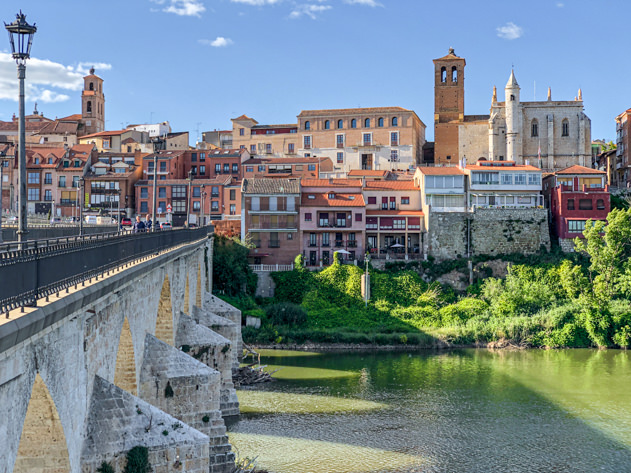
Tordesillas
Region: Castilla y León
Province: Valladolid
As a destination for the courtiers serving the Royal Family, Tordesillas had an intense past that is still visible nowadays through its monumental heritage. After walking around, you will notice that it has certainly retained its former glory.
These are the main sites that you should visit in Tordesillas:
- Museo del Tratado de Tordesillas: in 1494, the village hosted the signing of the historic Treaty of Tordesillas by which Spain and Portugal agreed to divide the territories of the New World among themselves. This free museum located in the Treaty Palace displays maps, books and navigation instruments that help understand that period. Every month of June, Tordesillas celebrates this key date.
- Monasterio de Santa Clara: this imposing convent founded in 1363 in the banks of the iconic Duero river was turned into an opulent palace that housed the mad Princess Juana la Loca, the daughter of the Spanish Queen Isabella the Catholic. This building is one of the best examples of Mudejar architecture, and its most notable elements include the main façade, the courtyard, the Arab baths, the Gothic church, and the Saldaña chapel.
- Plaza Mayor: as in other Castilian cities, the main square is surrounded by an arcade. You will find the major civil and religious buildings around it such as the City Hall and various churches (iglesia de Santa María, iglesia de San Juan, iglesia de San Antolín, iglesia de San Pedro, iglesia de Santiago).
- Puente medieval: to finish off your tour around Tordesillas, you may want to cross this medieval bridge over the Duero river. During the summer, you can even head to the ‘beach’ by the river.
Discover more destinations in Castilla y León.
Day 4: Simancas, Medina del Campo, Segovia
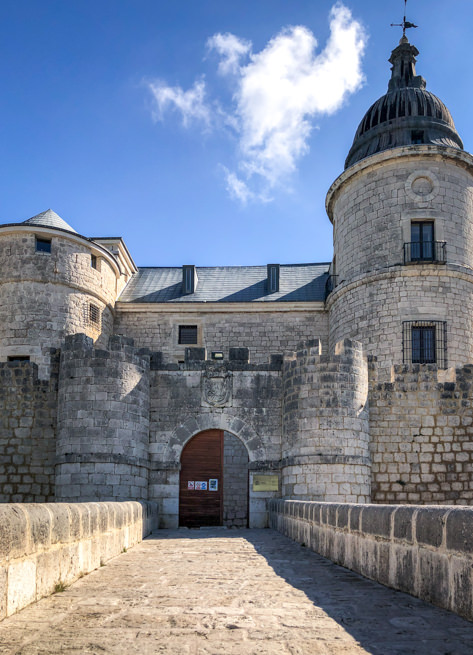
Simancas
Region: Castilla y León
Province: Valladolid
Located just 11kms southwest of the city of Valladolid, these are the main highlights you can visit in Simancas:
- Castillo de Simancas: since the reign of Spanish King Charles V, this magnificent castle holds the largest archive collection in the country from the 16th to the 18th centuries (Archivo General de Simancas).
- Plaza Mayor: in the nearby main square you will find a Gothic church dating from the 16 century (iglesia del Salvador).
- Finally, you may want to cross the medieval bridge over the Pisuerga river.
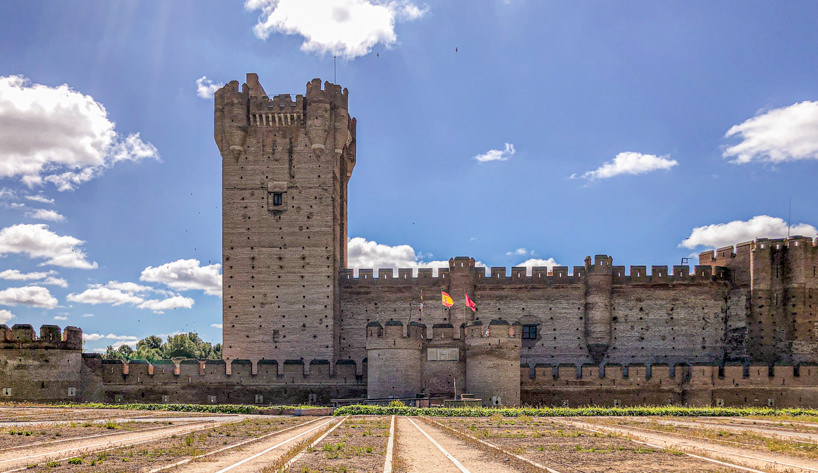
Medina del Campo
Region: Castilla y León
Province: Valladolid
Halfway on our Spain road trip was Medina del Campo. Some centuries ago, this small town also known as Villa de las Ferias was an important communications and commercial hub by the banks of the Zapardiel river.
Let’s discover what to see in Medina del Campo:
- Plaza Mayor de la Hispanidad: the main square is rather wide and encompasses a number of religious and civil buildings such as the temple of Colegiata de San Antolín, the City Hall (Ayuntamiento) and the palace where the Spanish Queen Isabella the Catholic made her last will before passing away in 1504 (Palacio Real Testamentario de Isabel La Católica).
- Palacio de los Dueñas: this nearby Renaissance palace was erected in the 16th century.
- Reales Carnicerías: this is the oldest food market in Spain and has been operating since 1562!
- Castillo de la Mota: crossing the Zapardiel river, you will find a truly imposing castle. This fortress blending Gothic and Mudejar styles was built in the 15th century and thoroughly restored in 1940. The main highlights include a tower (Torre del Homenaje), a courtyard (patio de armas), a chapel and a hall (sala de Juan de la Cosa). I recommend you book a guided tour to fully enjoy your visit.
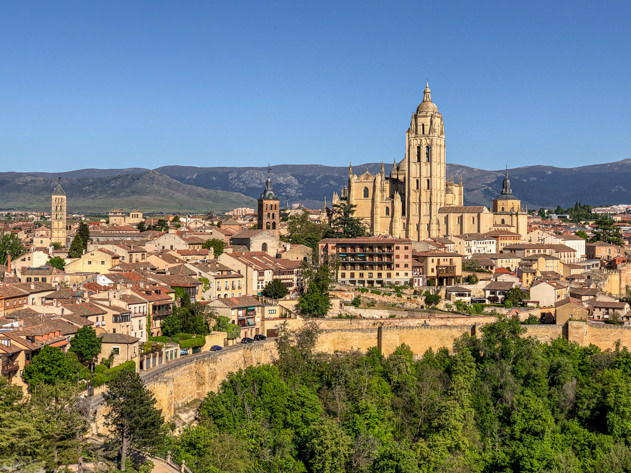
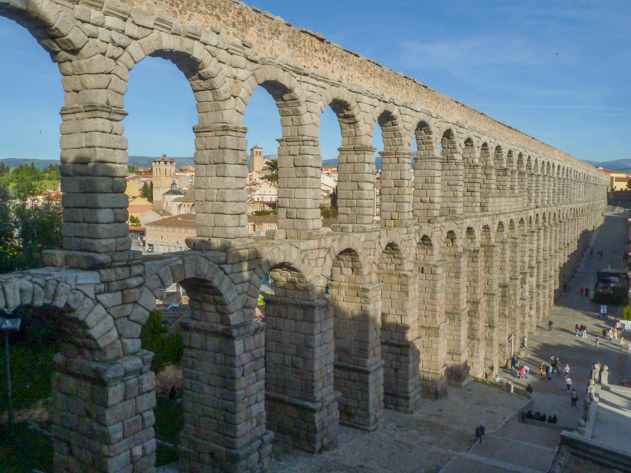
Segovia
Region: Castilla y León
Province: Segovia (it is the capital)
The city of Segovia was declared a UNESCO World Heritage site in 1985 for good reasons given its major artistic and architectural attractions.
Here’s what you can’t miss in Segovia:
- Acueducto de Segovia: this imposing Roman aqueduct has certainly stood the test of time. Can you believe it was erected in the 2nd century AD and brought water to the city of Segovia until 1973? Another fascinating fact is that its 167 granite arches were built using ashlars joined together without any type of mortar. Make sure to go up the stairs by the aqueduct for unforgettable views and pictures! Starting from the nearby Plaza del Azoguejo, you may follow Calle Real (encompassing calle de Cervantes, calle de Juan Bravo and calle de Isabel la Católica) to reach Plaza Mayor. From there, you just need to follow straight ahead all the way to the Alcázar.
- Alcázar de Segovia: this majestic fortress turned into a royal palace stands on top of a cliff overlooking the Clamores and Eresma rivers. Together with the Roman aqueduct, it is one of the two symbols of the city. You could easily spend hours visiting the endless chambers in the Alcázar and admiring its breathtaking views from Paseo de los Reyes. To save you some time, these are the essentials you should cover: patio de armas, sala de Ajimeces, sala de la Chimenea, salón del Trono, sala de la Galera, sala de las Piñas, cámara del Rey, Sala de los Reyes, sala del Cordón, tocador de la Reina, torre del homenaje, torre de Juan II. It is worth going up one of the towers to admire the panoramic views.
- Plaza Mayor: the main square of the city is surrounded by an arcade and hosts the City Hall (Ayuntamiento), a theater (Teatro Juan Bravo) and a church (iglesia de San Miguel).
- Catedral de Segovia: erected between 1525 and 1577, this Gothic masterpiece holds various treasures inside including a massive tower, an elaborate gate (puerta de San Frutos), a valuable altarpiece, various chapels, a splendid vault, a cloister and a museum.
- Some other churches in Segovia worth mentioning include iglesia de San Martín, built in the 12th century and located near the iconic Casa de los Picos, and iglesia de San Esteban, erected in the 13th century and featuring a magnificent tower.
Day 5: Alcalá de Henares, Guadalajara
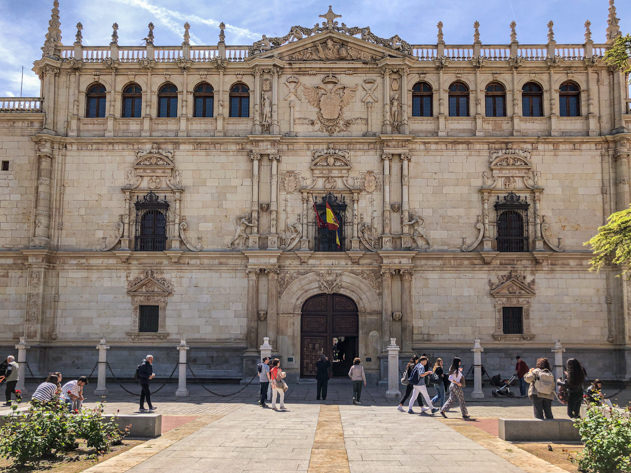
Alcalá de Henares
Region: Comunidad de Madrid
As the birthplace of Spanish writer Miguel de Cervantes in 1547, who authored the universally famous Don Quijote de la Mancha, Alcalá de Henares was declared a UNESCO World Heritage site in 1998. It is for sure one of the most monumental cities in Spain!
Let’s dive into what to see in Alcalá de Henares:
- Colegio de San Ildefonso: this imposing building is the headquarters of the University of Alcalá de Henares. Founded in 1498 by cardinal Cisneros, the singularity of the city is that it was purposefully designed to become the seat of a University. As a matter of fact, this ‘University City’ model was later on exported to other cities across Europe and the Americas. Some elements worth mentioning inside and around the University include a chapel dedicated to San Ildefonso and various schools that were built in the 16th and 17th centuries. But above all, THE landmark here is the main hall known as Paraninfo. To mark the anniversary of the death of Miguel de Cervantes and International Book Day on April 23rd, the Spanish King and Queen award the prestigious Premio Cervantes in this iconic location every year.
- The city of Alcalá hosts a variety of religious temples, from the monumental Archbishop’s Palace (Palacio Arzobispal), to the Cathedral (Catedral Magistral de los Santos Justo y Pastor de Alcalá de Henares) and numerous convents (convento de la Madre de Dios that houses the regional Archaeological and Paleontological museum, convento de San Bernardo, convento de Santa Úrsula, convento de la Consolación and convento de la Imagen).
- Museo Casa Natal de Cervantes: this house recreates Cervantes’ birthplace through a museum. A must-visit if you’re interested in this universal literary figure.
- Casa de la Entrevista: in this location, which was a former church, the Catholic Monarchs Isabella and Ferdinand met with Christopher Columbus before his first trip to America.
In case you’re visiting Alcalá de Henares from the capital city of Madrid, an interesting option is to hop on a train known as Tren de Cervantes, which includes a play during the short journey.
Discover more destinations in Comunidad de Madrid!
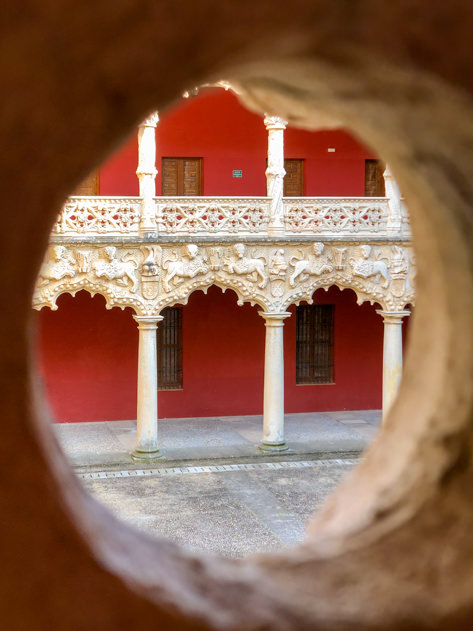
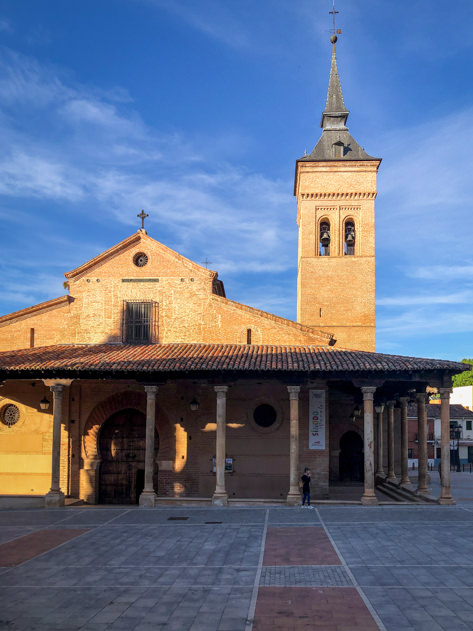
Guadalajara
Region: Castilla La Mancha
Province: Guadalajara (it is the capital)
This ancient city has preserved some notable monuments to this day. Currently, it is experiencing great dynamism due to its proximity to Madrid.
The main highlights in Guadalajara include the following:
- Palacio del Infantado: this palace built in the 15th century by Juan Guas for the powerful Mendoza family is, without a doubt, the most symbolic site in Guadalajara. The elements worth mentioning include its elaborate façade as well as the imposing courtyard known as patio de los Leones (a true gem!) and the surrounding gardens. Furthermore, the palace hosts the local museum (Museo de Guadalajara), displaying various sections on fine arts, ethnology and archaeology.
- Palacio de los Mendoza: a few steps away lies another elegant palace, which also belonged to the Mendoza clan. Erected around 1510 and turned into a convent (Convento de la Piedad), the main landmark is its courtyard. Palacio de la Cotilla is another nearby palace worth visiting.
- Concatedral de Santa María la Mayor: this cathedral is the most important temple in Guadalajara despite its modest size compared to other cathedrals in major Spanish cities. It was built taking advantage of a former mosque from the 13th century. As you might notice, the tower was a minaret beforehand and the entrance doors are Moorish looking. Right behind the cathedral you will find a medieval tower (torre del Alamín) and a bridge.
- You may also want to explore the numerous churches throughout Guadalajara, including the following: iglesia de Santiago Apóstol, iglesia de San Nicolás El Real, iglesia de San Ginés, iglesia de San Francisco. In the nearby parque de San Roque, you can visit an imposing pantheon dedicated to the countess of Vega del Pozo (Panteón de la Duquesa de Sevillano).
Day 6: Sigüenza, Medinaceli, Soria
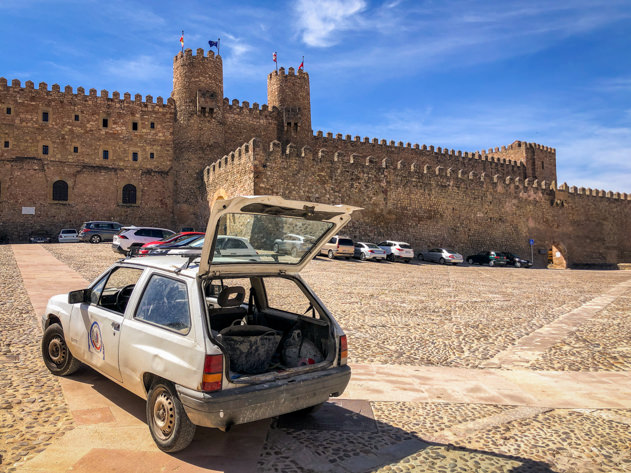
Sigüenza
Region: Castilla La Mancha
Province: Guadalajara
Sigüenza is synonymous with history, and its well preserved urban area that is full of medieval and Renaissance monuments, is a clear example of what ancient Spanish cities were like. It came as a complete surprise and was my favorite stop of the entire Spain road trip. I could picture myself buying an old house with a cozy fireplace here and remodeling it. 🙂
Are you ready to discover what to see in Sigüenza?
- Catedral de Santa María de Sigüenza: the cathedral is certainly the main attraction in town and is worth a thorough visit (we booked a tour with audio guides). The construction of this temple began in 1123, combining Romanesque elements early on with Gothic style. When visiting this masterpiece, pay attention to the following: the main façade, an imposing tower (torre del Santísimo), the monumental cloister, the sacristy (sacristía de las Cabezas), various gates (puerta del Mercado, puerta de San Valero, puerta de Jaspe), and chapels (Capilla Mayor, capilla de San Pedro, capilla de la Concepción, capilla de las Reliquias, sepulcro del Doncel Martín Vázquez de Arce) and a museum (Museo Diocesano de Arte Antiguo).
- Plaza Mayor: next to the cathedral you will find the main square and the City Hall (Ayuntamiento). Some churches (iglesia de Santiago, iglesia de San Vicente) lie steps away.
- Other monuments worth mentioning in Sigüenza include a palace from the end of the 15th century (casa del Doncel), the old City Hall (viejo Ayuntamiento), two ancient gates to the city (Puerta del Sol, Puerta del Hierro), and the magnificent castle at the end of the steep Calle Mayor, now turned into a hotel (Parador de Sigüenza).
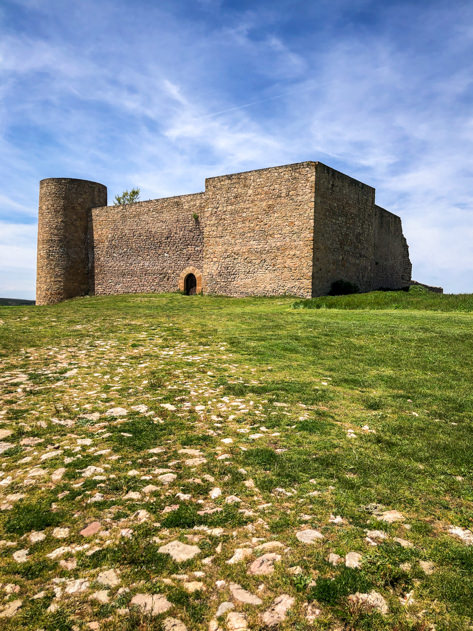
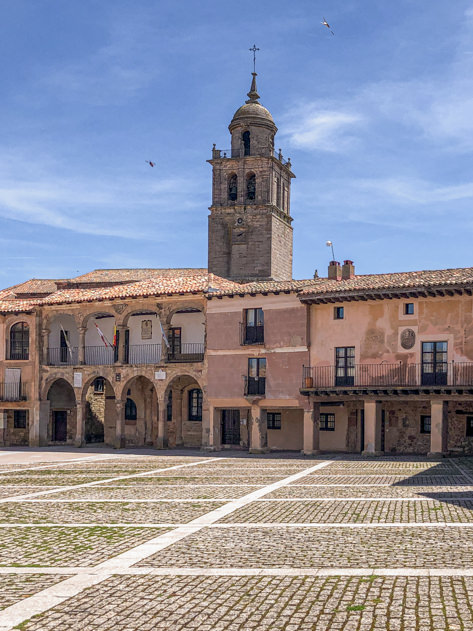
Medinaceli
Region: Castilla y León
Province: Soria
Known as Medina Selim in Arab times, this ancient small town strategically located on a hilltop now lying by the A-2 highway that connects Madrid, Zaragoza and Barcelona is actually considered one of the most beautiful destinations in Spain.
Below I have listed the sites you can’t miss when visiting Medinaceli:
- Arco del Triunfo: not to be mistaken with the Arc de Triomphe in Paris, this Roman triumphal arch with three arches was built between the 2nd and 3rd centuries. It is a unique architectural gem. There’s another arch at the other end of Medinaceli (Puerta o Arco Árabe).
- Castillo de Medinaceli: this simple Moorish fortress known as Alcazaba and dating back to the 9th century now hosts the local cemetery. Head to one of the viewpoints (Mirador del Castillo) for panoramic views.
- Plaza Mayor: the main square surrounded by an arcade holds an elegant noble palace from the 18th century (Palacio Ducal de Medinaceli, that displays Roman mosaics), a former warehouse (Alhóndiga), and an archaeological museum (Aula Arqueológica).
- Other religious landmarks worth mentioning are Colegiata de Santa María de la Asunción (from the 16th century), a former synagogue for the Jewish community (Beaterio de San Román) and an ancient convent (Convento de Santa Isabel).
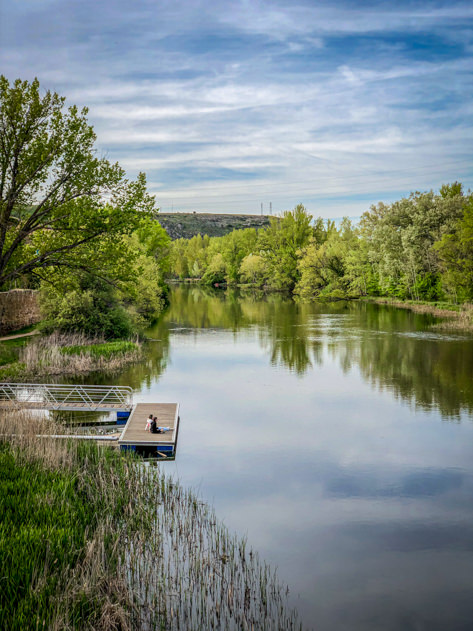
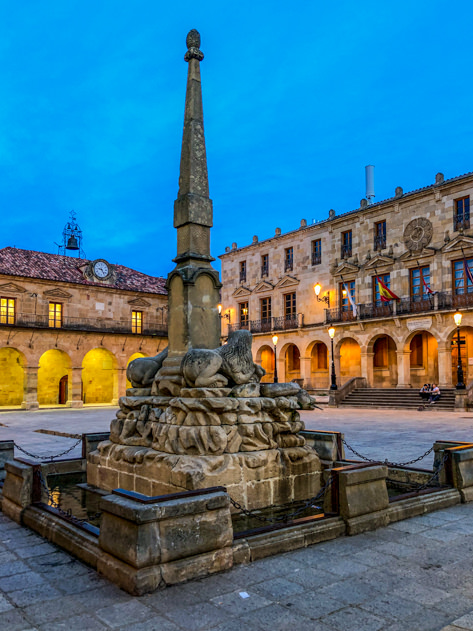
Soria
Region: Castilla y León
Province: Soria (it is the capital)
Despite being in one of the most unpopulated provinces in Spain, Soria is a small and peaceful city whose main attraction lies in its location next to the Duero river and in the Romanesque beauty of its monuments.
These are the must-visit sites in Soria:
- Plaza Mayor: the main square is a good starting point to discover the city of Soria. Around it, you will find relevant civil and religious buildings such as the City Hall – housed in Casa de los Doce Linajes-, Palacio de la Audiencia – now transformed in a cultural center-, a few churches – iglesia de Santa María la Mayor, iglesia de Nuestra Señora del Espino-, and the ruins of a medieval castle located in a park with great panoramic views (Parque del Castillo).
- Other temples worth mentioning in Soria include the cathedral (Concatedral de San Pedro) and some more churches (iglesia de San Juan de Rabanera, iglesia de Santo Domingo de Soria – make sure to check out its beautiful façade and rose window-). If you cross the Duero river over the stone medieval bridge, you will find two monasteries (monasterio de San Juan de Duero, monasterio de San Polo) and a hermitage (ermita de San Saturio). I actually recommend you take it easy and walk along the river. It was our favorite part of visiting Soria: slow travel at its best!
- Back in town, you may also want to explore the museum (Museo Numantino, which displays archaeological artifacts from the Soria province) next to the park Alameda de Cervantes, noble mansions along calle de los Caballeros, and an imposing Renaissance palace (Palacio de los Condes de Gómara).
Day 7: Logroño, Puente la Reina
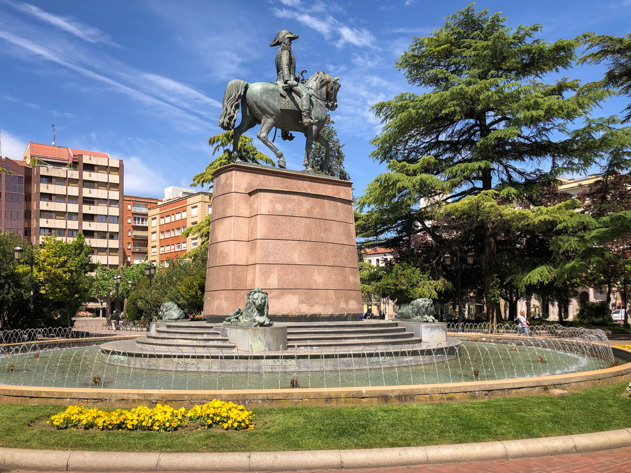
Logroño
Region: La Rioja (Logroño is the capital)
Known as the wine region of Spain thanks to its worldwide famous La Rioja wines, Logroño is a modern and elegant town that preserves an interesting monumental city center. As part of St James’ Way (Camino de Santiago), it is an important stage along the iconic French Way (Camino Francés) that also leads to Burgos, León and eventually Santiago de Compostela.
Let’s discover what to see in Logroño:
- Parque del Espolón: this large park can be a great start to your itinerary around the monumental city of Logroño. At the heart of it you will find an equestrian statue dedicated to General Espartero, who died here in 1879.
- As you may imagine, since Logroño lies along the Camino de Santiago, there are a variety of churches. The most important are: the cathedral (Concatedral de Santa María de la Redonda, featuring a magnificent façade and two slim towers), iglesia de San Bartolomé, iglesia de Santa María de Palacio (built in the 12th century, it includes an elegant tower and a monumental altarpiece), and iglesia de Santiago (dating from the 16th century and bearing a special significance for pilgrims of St James).
- The elegant palace from the 18th century now housing the Instituto de Estudios Riojanos (Palacio de los Chapiteles), the remains of the old city walls (El Revellín), the theater (Teatro Bretón de los Herreros), Instituto Sagasta, a market (Plaza de Abastos-Mercado de San Blas) and the iron and stone bridges crossing the Ebro river are other sites worth exploring.
- To finish off your visit to Logroño, you may head to the modern part of the city, which includes attractions such as museums (Museo de la Rioja, Casa de las Ciencias and Museo Würth La Rioja – in nearby Alberite), a state-of-the-art convention center (Riojaforum Palacio de Congresos y Auditorio de La Rioja) or the new City Hall (Ayuntamiento).
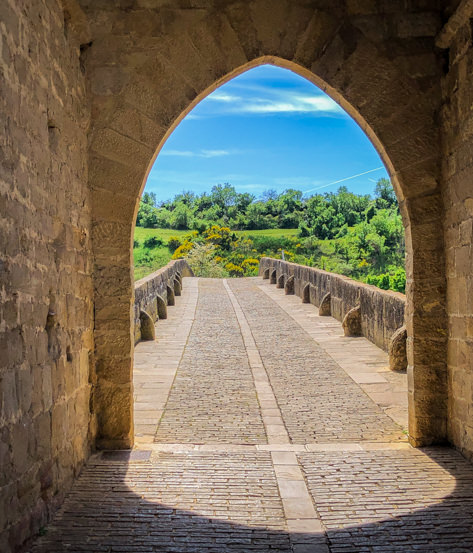
Puente la Reina
Region: Navarre (also known as Navarra in Spanish, or Nafarroa in Basque)
Our last stop of this Spain road trip around 16 monumental cities was Puente La Reina (also known as Gares), which treasures an intense past thanks to its strategic location along the iconic Camino de Santiago.
- The pilgrims’ great fervor explains the number of religious temples in such a small location. The main highlights include various churches (iglesia del Crucifijo, iglesia de Santiago and iglesia de San Pedro) and a convent (convento de Comendadoras de Sancti Spiritus).
- The iconic Romanesque bridge over the Arga river connects the main street (Calle Mayor) with the main square (Plaza Julián de Mena) and the City Hall (Ayuntamiento). If you visit early in the morning, chances are you´ll spot many pilgrims crossing the bridge to head towards Santiago de Compostela.
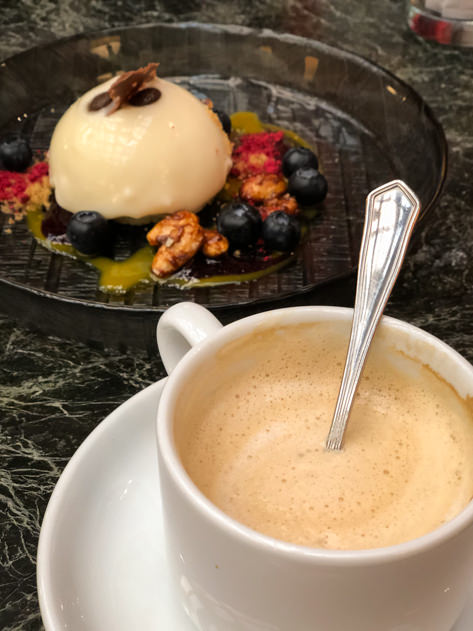
What and where to eat in northern and central Spain
Throughout this Spain road trip around 16 monumental cities, we visited a number of regions (or Comunidades Autónomas in Spanish), each of them featuring a wide array of products, from fresh fish and cider, to roast meat dishes and mouthwatering sweets. We’re lucky to find such diverse and delicious food in our country!
For your ease of reference, I’ve listed where we ate region by region in chronological order, and which are the most typical dishes. Furthermore, I also included the names in Spanish so you can quickly locate the regional specialties on the menu. Enjoy this gastronomic tour! 🙂
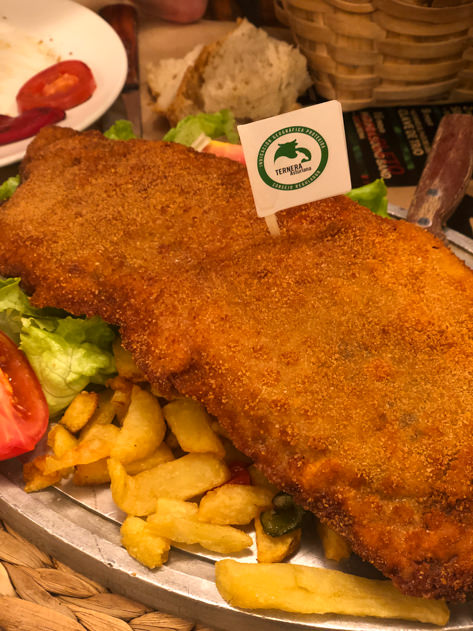
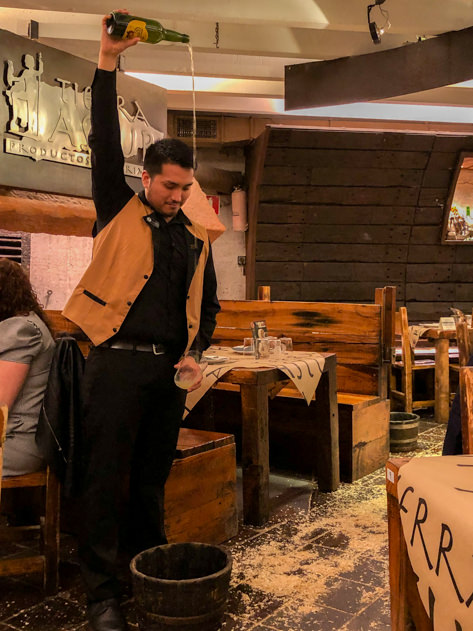
What and where to eat in Asturias
The region of Asturias lies between the sea and the mountains, hence offering a variety of fresh produce. Also, note that locals are known for their abundant servings, so make sure to seat on an empty stomach whenever you go to a restaurant! 🙂
Typical products from Asturias:
- Cheese: the most famous Asturian cheese varieties include Cabrales, Vidiago and Gamonedo (also known as Gamonéu).
- Drink: cider (sidra). Head to traditional sidrerías to see how locals master the art of pouring the cider (called ‘escanciar‘) , such as Calle Gascona in Oviedo.
- Meat: fried veal fillets with ham and cheese (cachopo), beef in white wine (carne gobernada)
- Vegetables: beans (fabes) are a regional staple food and are served in delicious dishes such as fabada asturiana or fabes con almejas (beans with clams).
- Desserts: burned rice pudding (arroz con leche quemado), a kind of crêpes (frixuelos) or dough enriched with lard and filled with walnuts and anise (casadielles).
Where we ate in Asturias:
- Casa Julio (Oviedo): nothing remarkable about this bar, although we stopped here for a quick snack as it was pouring rain and other restaurants were fully booked.
- Eurostars Hotel de la Reconquista (Oviedo): we had a glorious afternoon snack in this iconic hotel while it was raining outside. A pure moment of joy!
- Sidrería Tierra Astur (Oviedo): we enjoyed a traditional Asturian dinner including cider tasting in this restaurant along the famous Calle Gascona, which is renowned for housing plenty of cider bars (sidrerías). We order grilled vegetables and a fried veal fillet with ham and cheese (cachopo) to share.
- Confitería Rialto (Oviedo): we had a great breakfast at this traditional sweet shop by the university. They have two locations in Oviedo and another one in Madrid. Make sure to try their delicious moscovitas, made with almond paste and chocolate coating. Other sweet specialties include carbayones and princesitas de Asturias.
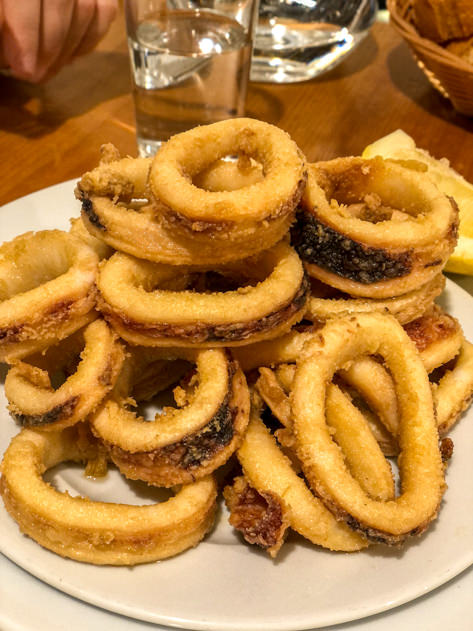
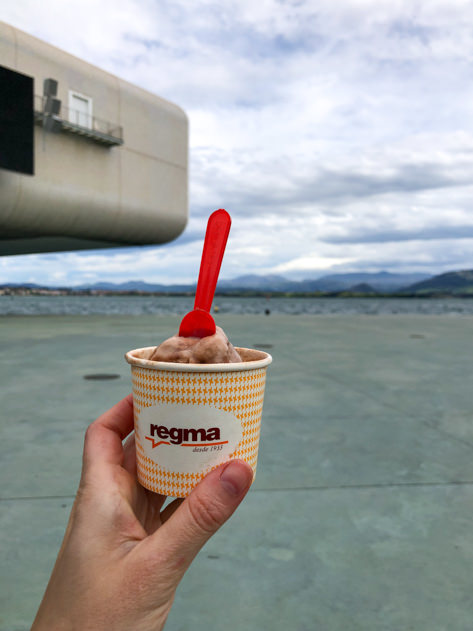
What and where to eat in Cantabria
Given its particular location, the region of Cantabria also features the best of both worlds: fresh seafood and fish from the sea and rivers, as well as delicious meat and dairy products thanks to its peaceful cows grazing on verdant hills.
Typical products from Cantabria:
- Fish and seafood: fresh from the Cantabrian Sea – fried calamari (rabas, calamares fritos), battered anchovies (bocartes rebozados), cuttlefish (cachón), barnacles (percebes), velvet crabs (nécoras), langoustines (cigalas), or a tuna stew (sorropotún) – or from the Cantabrian rivers – trout (trucha), salmon (salmón), elver (angulas).
- Meat: the excellent bovine meat is usually cooked in stews or grilled.
- Desserts: rice pudding (arroz con leche), fried milk (leche frita), custard (natillas), small sponge cakes (sobaos pasiegos) and a dense milk pudding (quesada).
Where we ate in Cantabria:
- Bodegas Mazón (Santander): we had a great meal in this former winery founded in 1902. We ordered the following: fried peppers (pimientos del Padrón), fried chorizo (chorizo frito de Potes), fried anchovies (bocartes fritos), fried calamari (rabas), artichokes with mushrooams and foie (alcachofas con setas y foie).
- Regma (Santander): if you visit the city, you must try their delicious ice creams. But beware, as they are gigantic even if you ask for the smallest size! This chain also bakes cakes.
- La Terrazuca (Comillas): we dined in this restaurant sitting on top of one of the central squares in the village, and we had a salad (ensalada la terrazuca), blood sausage with apple sauce (morcilla con manzana) and Picón cheese with toasted bread (queso Picón con pan tostado).
- Cafetería Samovy (Comillas): we came here for breakfast as I had read that their hot chocolate with churros was worth it, although it turned out it wasn’t. We had chocolate con churros, a coffee with a croisssant, a corbata de Unquera and a sobao.
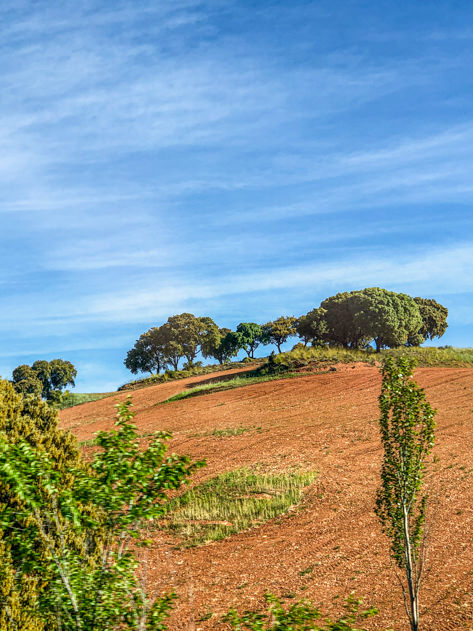
What and where to eat in Castilla La Mancha
In this inland region of Spain, the cuisine is rather simple, originating in the humble dishes that the shepherds used to prepare on the go. If you´ve read the famous novel Don Quixote, you may recognize some recipes reflected in that literary masterpiece.
Typical products from Castilla La Mancha:
- Meat and fish: roast lamb and goat (asado de cordero y cabrito) with Jadraque sauce (made with vinegar and aromatic herbs), stewed quail (codornices estofadas) or rabbit (conejo) predominate. As for fish, you can try trout with ham (trucha con jamón).
- Other traditional dishes include beans (judías alcarreñas), porridge (gachas), scrambled eggs with chorizo and bacon (duelos y quebrantos), a pâtélike spread of game meats with spices and bread (morteruelo serrano), ratatouille (pisto), and a dish made with stale bread and fried eggs (migas de Sigüenza).
- Manchego cheese (queso manchego) deserves a special mention!
- Desserts: candied egg yolks (yemas de Doncel), sponge cakes (bizcochos borrachos), compote with honey and walnuts (letuario de miel con nueces). Don’t forget to try the Alcarria honey when visiting the region!
Where we ate in Castilla La Mancha:
- El Buen Vivir (Guadalajara): we met with some relatives for dinner here. We ordered the following to share: eggplant sticks (palitos de berenjena), tempura octopus (pulpo en tempura), mini beef and oxtail burgers (mini hamburguesas de ternera y rabo de toro), broken eggs with ham and mushrooms (huevos rotos con jamón y setas).
- Parador de Sigüenza (Sigüenza): this fortress turned into a hotel symbolizes medieval splendor at its best. We had a quick and rejuvenating snack at the cafeteria, with coffee, cake (bizcocho de la abuela) and a salmon toast.
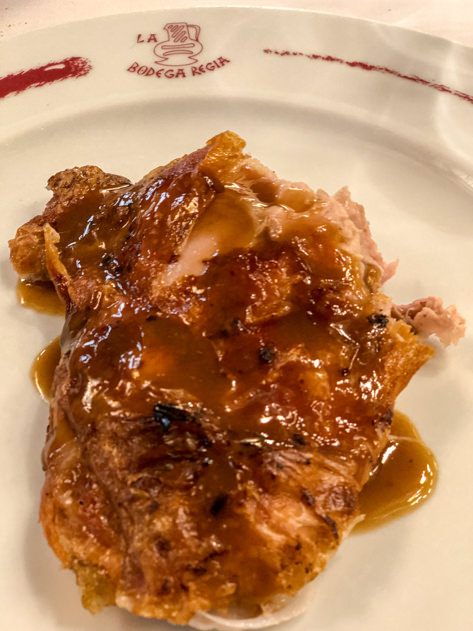
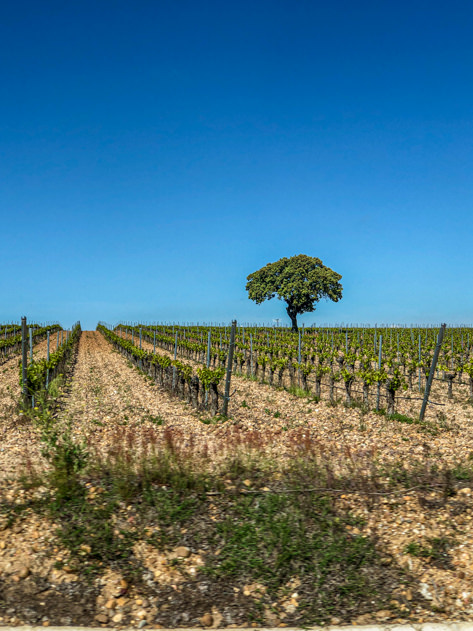
What and where to eat in Castilla y León
As the largest Spanish region (Comunidad Autónoma), the cuisine in Castilla y León predominantly features roast suckling pig and lamb, although each of the nine provinces has their own traditional products, such as charcuterie in the León province (chorizo, blood sausage –morcilla-, cured meat –cecina) or the renowned butter in Soria province (mantequilla de Soria).

Typical products from Castilla y León:
- Meat and crustacean: roast meat is the absolute king in this region, especially pork and lamb. Roast suckling pig (known as cochinillo, lechón or tostón), fried bacon (torreznos), meat stew (caldereta), and roast lamb (cordero asado) are among the must-try dishes. Crayfish stew (guiso de cangrejos de río) is also popular.
- Wine: Ribera del Duero, Rueda and Toro wines are some of the varieties you will find here, which are perfect to pair with the hearty meat.
- Other traditional regional dishes include garlic soup (sopa de ajo), Castilian soup (sopa castellana), or recipes with mushrooms (setas de cardo), truffles (trufa) or stale bread (migas).
- Desserts: you can find a wide variety, such as coconut cakes (cocadas from Medina del Campo) or candied egg yolks (yemas de Ávila from Ávila).
Where we ate in Castilla y León:
- Restaurante Bodega Regia (León): this was probably the best meal of our entire Spain road trip. Delicious food and impeccable service made this lunch break such a memorable experience. This is what we ordered in this traditional restaurant: stew soup (sopa de cocido), homemade croquettes (croquetas de Ana, truly to die for!), salad (ensalada de ventresca y cogollos), suckling lamb (lechazo delantero) and chestnut cake (tarta de castañas).
- Hotel Restaurante El Montico (Tordesillas): we had dinner at the hotel restaurant (two salads and battered chicken wings), but the food was rather bland. We also had breakfast here the next day.
- Taberna Mohíno (Medina del Campo): we greatly enjoyed our lunch in this modest restaurant, where we ordered stew soup (sopa de cocido), ratatouille (pisto), green beans with ham (judías verdes con jamón), stew meat (segundo de cocido), roast beef (ternera asada), beef tongue (lengua de ternera), roasted apples (manzanas asadas) and cheese crème caramel (flan de queso). Quick service and good food at a reasonable price.
- Restaurante José María (Segovia): lovely dinner at this traditional restaurant just steps away from the Cathedral. We had Castilian soup (sopa castellana), tempura vegetables (verduras en tempura), a salad (ensalada sencilla) and the famous local piglet (cochinillo).
- Parador de Segovia (Segovia): we had a memorable breakfast while enjoying a panoramic view of the monumental city.
- Restaurante Romano II (Medinaceli): we enjoyed a nice lunch in the terrace, a few steps away from the iconic Roman Arch. We ordered Castilian soup (sopa castellana), artichokes with ham (flores de alcachofas con jamón), salad with goat cheese (ensalada con queso de cabra), barbecue ribs (costillar a la barbacoa), lamb stew (caldereta de cordero), puff pastry cake (tarta de hojaldre), yoghourt with berries, and an apple.
- El Kiosco de Soria (Soria): we found this lovely spot located in the park Alameda de Cervantes by surprise and really enjoyed decompressing here after a long day walking around. We shared some olives, fried bacon (the famous ‘torreznos de Soria‘), a tomato salad with tuna belly and some croquettes.
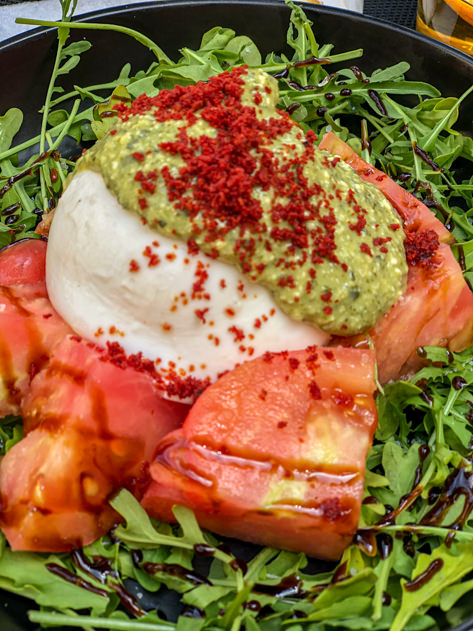
What and where to eat in Comunidad de Madrid
As the region hosting the capital city of Madrid, you will find a combination of traditional recipes while also featuring some influence from the Castilian cuisine.
Typical products from Comunidad de Madrid:
- Hearty meals from this central Spanish region include the Madrid-style stew (cocido madrileño), Madrid-style tripe (callos a la madrileña), broken eggs (huevos rotos), large beans (judiones de la Granja) or the calamari sandwich (bocata de calamares).
- Desserts and sweets: melons from Villaconejos, strawberries from Aranjuez and hot chocolate with churros or porras (chocolate con churros o porras).
Where we ate in Comunidad de Madrid:
Magistral Gastrotaberna (Alcalá de Henares): we really enjoyed eating in this restaurant outdoors by the Cathedral. We had carrot and orange soup (crema de zanahoria y naranja), a salad, Bilbao-style sea bream (dorada a la bilbaína), chicken skewer with rice and aioli (brocheta de pollo con arroz y alioli), burrata with tomato and cashew pesto (burrata con tomate y pesto de anacardos).
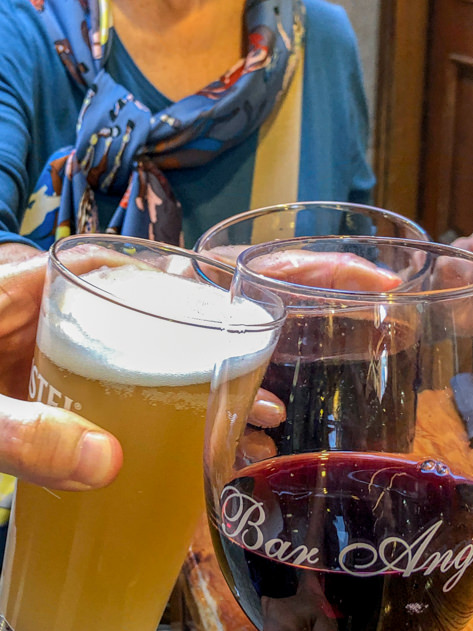
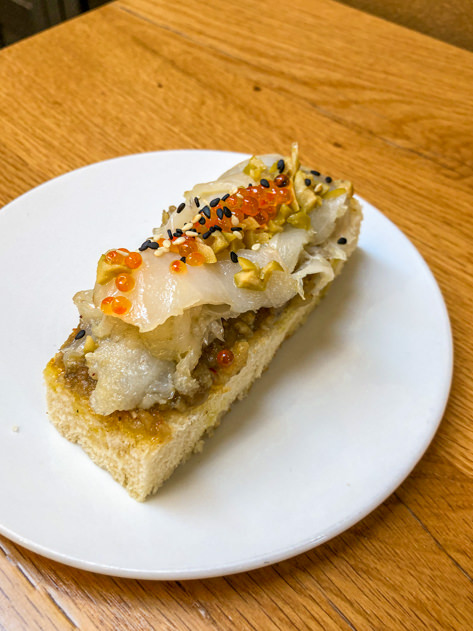
What and where to eat in La Rioja
The traditional cuisine from La Rioja is based on vegetables growing on this fertile land, paired with worldwide famous Rioja wines and delicious meat.
Typical products from La Rioja:
- The most traditional regional dishes include potatoes Rioja style (patatas a la riojana) and lamb chops with vine shoots (chuletillas de cordero al sarmiento).
- Wine: if you’re a wine lover, you’re in luck! Here, you’ll be able to taste Rioja wines in the endless wineries as well as in the bars and restaurants throughout the region.
Where we ate in La Rioja:
When in Logroño, head to the famous Calle del Laurel, which is famous for its endless bars offering ‘pinchos‘ (like tapas) or Calle Bretón de los Herreros. We stopped in the following bars around Calle Laurel:
- Bar Ángel: their specialty are grilled mushrooms served with a bread toast and a shrimp (pincho de champiñón a la plancha). Order this and a glass of Rioja wine, and thank me later.
- La Tabola: we ordered two lamb brioches and a cod bite. Yum!
- Bar El Muro: we tried the Ferrero Rocher made of blood sausage and cheese, as well as a meat ball.
- Tío Agus: I had the spicy sausage skewer, delish!
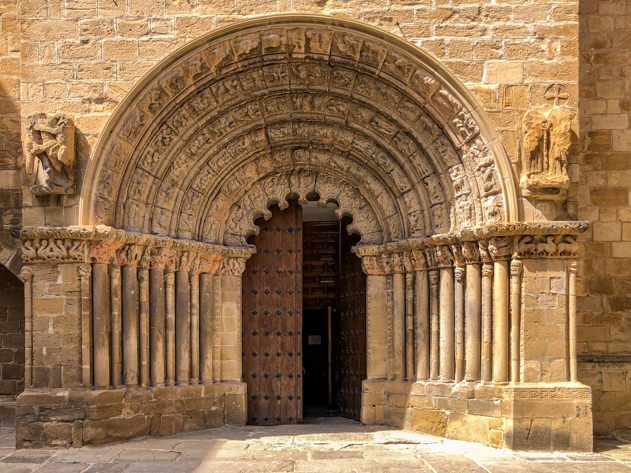
What and where to eat in Navarre
The region of Navarre features diverse landscapes, from large rivers and verdant forests to vast pastures, translating into top-quality products. Note that, as in Asturias, the servings tend to be very generous in this region as well.
Typical products from Navarra:
- Cheese: you should definitely try the delicious Idiazabal and Roncal cheese varieties.
- Meat: fast-cure sausage (chistorra), roast lamb or with tomato and pepper sauce (cordero asado o al chilindrón).
- Fish: as the famous novelist Hemingway wrote during his various trips to Spain, you will find delicious specialties such as the Navarran-style trout stuffed with ham (trucha a la navarra) or fish with garlic and spices (bacalao ajoarriero).
- Vegetables: there are plenty to choose from, but the absolute kings would be the asparagus (espárrago), the cardoon (cardo) and the red peppers (pimientos del Piquillo).
- Drinks: sloe brandy (pacharán) and Navarran wines.
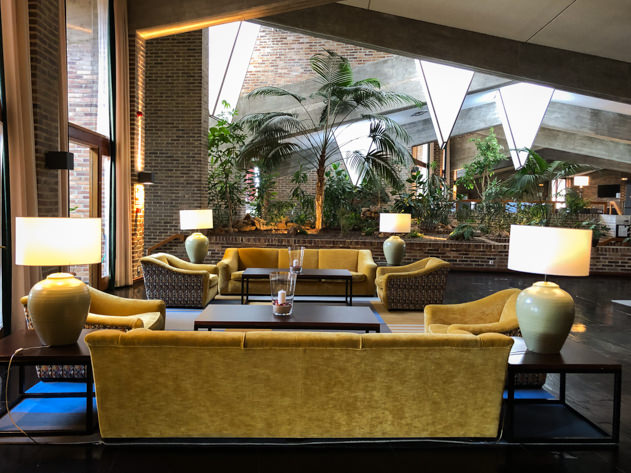
Where we stayed throughout our Spanish road trip
During our 7-day long Spain road trip, these are all the places where we slept:
- Hotel Solatorre (Comillas): this 2-star hotel is located near the University and walking distance from the village. Good location overall, but rather basic facilities. Also, there were quite a few steps to get from the parking to the rooms, so I wouldn’t recommend it for disabled guests. Breakfast wasn’t included and I could hear other guests staying next door overnight.
- Viviendas Oviedo Catedral (Oviedo): we loved staying in this modern apartment, literally a few steps away from the main sites in the city, including the Old Town and calle Gascona. Breakfast wasn’t included.
- Hotel Restaurante El Montico (Tordesillas): we had stayed here in previous years, but the hotel is now in pretty bad shape and looking quite deteriorated, especially the outdoor facilities such as the tennis courts and the swimming pool. Moreover, they ran out of water when I was taking my morning shower! I would definitely not book this accommodation again despite the good old memories. Breakfast was included, but was rather modest.
- Parador de Segovia (Segovia): I love staying at ‘Paradores‘ whenever we travel around Spain, as they are typically historic buildings turned into hotels and you can get a flavor of their significance. Even though the Parador in Segovia was built in the 70s, it features impressive panoramic views of the city. Our room was spacious and comfortable.
- Hotel El Sueño del Infante (Guadalajara): modest facilities but great location a few steps away from the iconic Palacio del Infantado. Breakfast was included, and was rather simple.
- Parador de Soria (Soria): we really enjoyed our last night of the Spain road trip sleeping here. The hotel is located on a hill, hence featuring panoramic views over both the city and the banks of the Duero river. Spacious and comfortable room with a lovely terrace, yummy breakfast and short walking distance to the major sites in Soria.
More travel inspiration: around Spain and other road trips destination ideas
If this itinerary around 16 Spanish monumental cities left you wanting some more, you’re lucky because I compiled additional suggestions.
In case you would like to discover more throughout Spain…
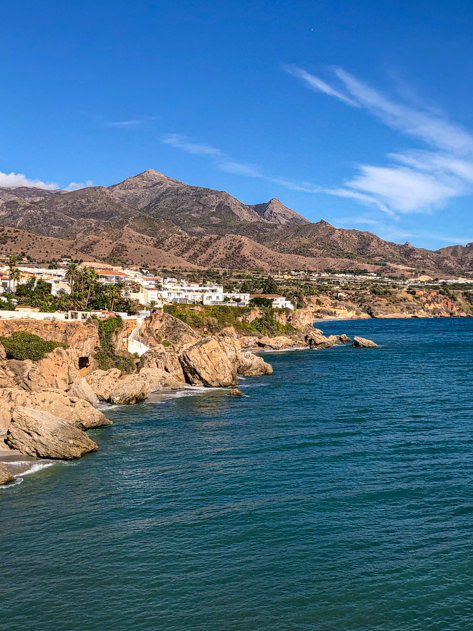
Browse my Spain destination page for more content about this fascinating country!
Camino de Santiago: hiking from Irún to Deba along the ‘Camino del Norte’
Granada travel guide: best things to see and do in 24 hours
My top five museums to visit in Guipúzcoa
Top things to do in Málaga, the capital of Costa del Sol (+ map)
What to do around Salas de los Infantes (Burgos)
Where to eat and drink in Barcelona: my favorite spots (+map)
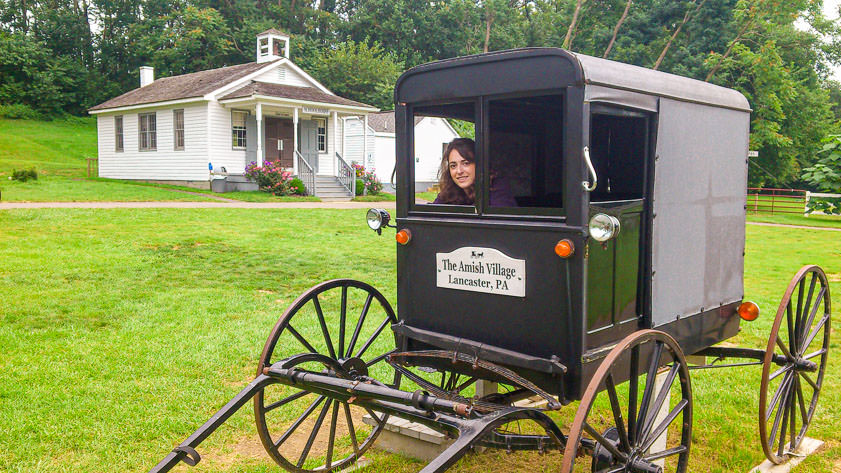
And if you felt inspired by this road trip,…
Check out more road trip destination ideas below!
A fun Memorial weekend in Philadelphia, Six Flags & Rehoboth Beach
Family road trip (New York + Long Island, Boston, Niagara Falls, Toronto, Amish territory + Philadelphia)
Spring break road trip (from Washington DC to Charleston, Savannah, northern Florida, New Orleans & Laura Plantation, Memphis, Nashville, the Great Smoky Mountains)
What to visit on a road trip to Virginia in 3 days
Map with our Spain road trip itinerary
For your ease of reference, I color coded the destinations that we visited in blue. The restaurants that we tried along our Spain road trip are shown in orange, and the hotels where we slept come up in grey.
This is a wrap! During this road trip adventure throughout northern and central Spain, I loved visiting so many destinations, big and small, rural and urban, old and brand new on my travel bucket list. It only reconfirmed how beautifully diverse my country is, and was a stark reminder of the stunning heritage we should aim to preserve for both current and future generations. I specially enjoyed discovering Spanish locations off the beaten track such as Soria or Guadalajara (the landscapes in this province were a dream come true!).
How did you like this post about our 7-day Spain road trip around 16 monumental destinations? Feel free to leave your questions and comments below. I look forward to reading them!
| GET READY FOR YOUR NEXT TRIP! |
|---|
| Browse my travel resources to plan your upcoming trip. |
| Feeling adventurous? Book any outdoor activities worldwide with Manawa! |
| Get medical or health insurance via SafetyWing for extra peace of mind. |
| Looking for sports equipment? Feel free to browse my Decathlon profile for inspiration. |
| Use the Anaya Touring travel guides to plan your trip, they’re really comprehensive and helpful! |

